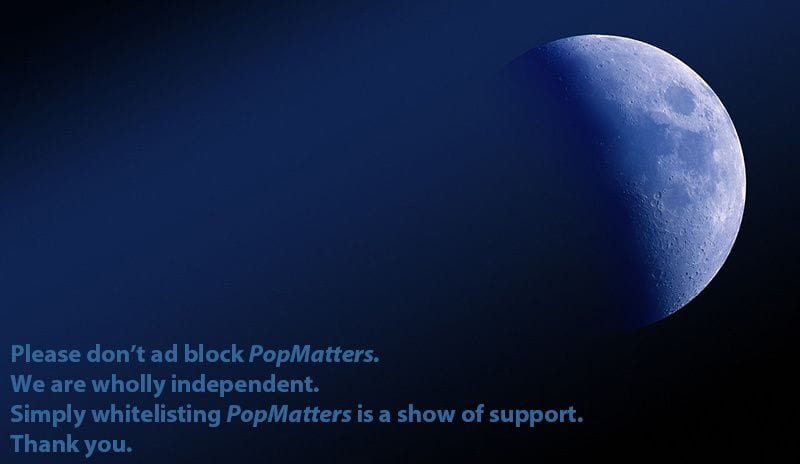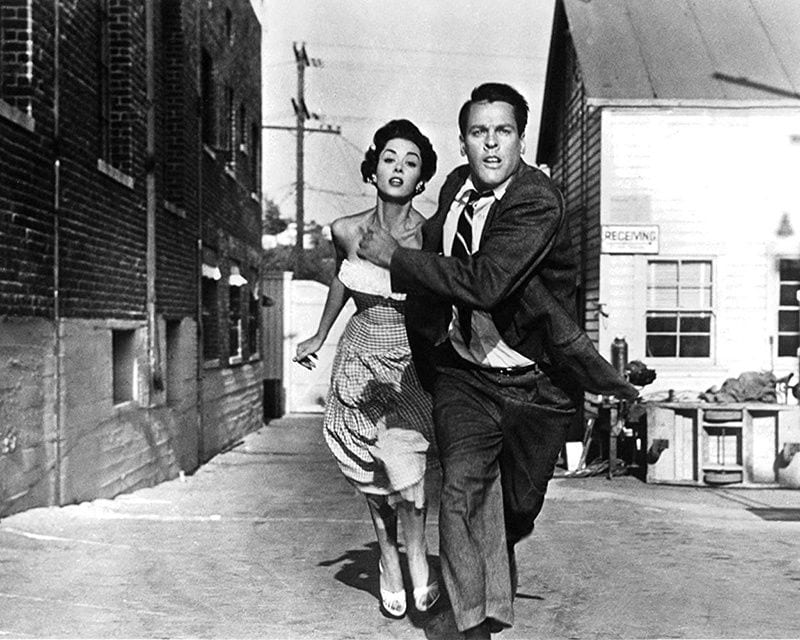
“In my practice, I’ve seen how people have allowed their humanity to drain away, only it happens slowly instead of all at once. They didn’t seem to mind.” So speaks Dr. Miles Bennell (Kevin McCarthy), looking out the window at what’s become of his town and pausing for moment of quiet reflection in the middle of the morass of palpable paranoia and escalating terror that is Don Siegel’s Invasion of the Body Snatchers (1956).
Bennell is speaking to Becky Driscoll (Dana Wynter), and the two of them may be the last members of the community who haven’t been turned into emotionless “pod people”. (Although that phrase derives from this movie, nobody in the film actually says it.) Bennell continues, “All of us, a little bit, we harden our hearts, grow callous. Only when we have to fight to stay human do we realize how precious it is to us, how dear, as you are to me.” Then they kiss with passion, a recurring gesture in the movie. Earlier, just before he kissed her for the first time, he used the action to demonstrate how he’d recognize her. Later, their final kiss will be equally decisive.
Jack Finney‘s novel The Body Snatchers, first serialized in Collier’s Magazine in 1954, has been filmed officially four times. All are worth watching. The original version, fabricated in the middle of the ’50s, has had the biggest cultural impact and remains the most beloved incarnation. Olive Films has just upgraded it no-frills 2012 disc as part of its Olive Signature line by adding a passel of new Blu-ray material, some new and some created for a 2006 50th anniversary disc that never got released.
One of the movie’s ironies is that the fictional California town of Santa Mira, which evidently means “look at the saint” or “witness the holy” or something along those lines, looks the same on the surface, as Miles’ narration informs us at the beginning. If anything, it’s calmer and more orderly as the invasion continues and citizens are replaced by shells of their former selves. They’re building the perfect American town, the embodiment of all those carefree (and all-white) suburbs seen in the era’s family sitcoms, where no problems are truly serious.
As the replacements imply, it’s certainly a way to solve all the problems that plague us — “an untroubled world” of “no more tears”. “Love, desire, ambition, faith — without them life’s so simple.” The converted citizens call the rest of the wayward souls fools for resisting what’s really not a problem. As the body-snatching trope became culturally pervasive, we’ve seen variants in which aliens who assume human bodies and memories become “infected” and altered by such qualities as love — see, for example, Jack Sholder’s The Hidden (1987) — but no such wrinkle is visible in this early example.
It’s no wonder that the film is rich fodder for cultural interpretation and critique, as shown in PopMatters’ review of the BFI volume on this picture. The reason the movie lends itself so easily to being perceived as a “Reds under the bed” anti-Communist fantasy and, with equal aplomb, as a critique of HUAC‘s anti-commie witch-hunts, is that both impulses are mirror images that center on the same concern: conformity vs. individuality, or the ideologies of control.
That’s the theme explicitly addressed in Daniel Mainwaring’s script and Finney’s novel. As Kier-La Janisse explains in the disc’s booklet, 1950s sociologists were making hot topics of conformity and identity, with people already fretting about the identical suburban Levittowns, a visible sign and enabler of social mobility — here comes the neighborhood — that would be mocked in Malvina Reynolds’ 1962 song, “Little Boxes“.
Cultural guardians worried about the postwar world of big business and advertising and The Organization Man, William H. Whyte’s 1956 hand-wringing bestseller that followed fast upon Sloan Wilson’s 1955 bestselling novel The Man in the Gray Flannel Suit. Paul Goodman’s Growing Up Asburd: The Problems of Youth in the Organized Society summarized many of these fears in 1960.
In other words, the more closely you examine American culture of the ’50s, the more you see it defined by atomic-age fears, hysterias, neuroses, discontents and profound fissures around class, race, sex roles, politics, the Cold War, industrialization, and the “howl” (Allen Ginsberg’s word) against the status quo. “Status quo” was also a big buzz term. Attempts to see the Eisenhower era as somehow calm and orderly, which is the extreme fantasy generated by sitcoms and nostalgia, crash head-first into the historical reality of a time when people were anything but calm. Be-bop doesn’t develop in a relaxed world.
Outside of those sitcoms, most cultural expressions of American suburbia and even of old-fashioned small towns presented them in a context ranging from genial mockery to unease, the balance struck by Alfred Hitchcock’s The Trouble with Harry (1955, the year Siegel shot his film) and mined in his TV series Alfred Hitchcock Presents, which premiered that fall. 1956, the year Siegel’s film was released, is also the year Grace Metalious’ Peyton Place became the decade’s most scandalous bestseller. We’ll toss out one more cultural milestone: Charles Schulz launched Peanuts, an anti-cozy comic strip on the miseries of a neurotic every-child and his flawed circle, in 1950 and saw it become the most popular strip by decade’s end. Good grief!
All this helps explain why the ’50s yielded films like Invasion of the Body Snatchers, which tapped into these cultural jitters without even alluding to most of them. You can catch the tip of that iceberg implied briefly in a snatch of dialogue when the local shrink (Larry Gates) refers to “a strange neurosis, evidently contagious, an epidemic of mass hysteria.” When Miles asks the cause, the answer is “Worry about what’s going on in the world, probably.” That’s bland and vague yet says it all.
As Joe Dante observes in a bonus feature, the “aliens replace your family” trope had been explored in two 1953 movies, William Cameron Menzies’ Invaders from Mars and Jack Arnold’s It Came from Outer Space, although the aliens prove benign in the latter film. He also observes that these, like most of the decade’s sudden flood of science fiction movies, were essentially aimed at kids, while Siegel’s film was an adult drama. It retrospect, one of its striking details is handled almost invisibly because the Production Code was leery of emphasizing it: both Miles and Becky are divorced. This simply wasn’t true of the heroes and heroines of most of the decade’s films; it’s why Doris Day’s single moms were always widows.
Dante joins McCarthy and Wynter (both now deceased) on one commentary track, while a second track by Richard Harland Smith gives detailed production commentary and background on the actors. Both tracks mention that illustrious producer Walter Wanger, who’d briefly gone to prison for non-fatally shooting the lover of his wife Joan Bennett, emerged from the hoosegow with plans to produce an exposé of prison life, and that was Siegel’s hit Riot in Cell Block 11 (1954). He’d develop those plans further in another hit, Robert Wise’s I Want to Live (1958), but first he became so captivated by Finney’s magazine serial that he purchased it before the final installment was complete.
As fans know, the original idea was to end the film bleakly, with a frantic, hysterical Miles running between the uncaring drivers of a crowded highway like a mad prophet, feverishly shouting “You’re next!” directly into the camera. As horns blare and we fear our hero is likely to be crushed at any moment, that dizzying highway scene is as perfect an emblem of the individual vs. the mindless, conformist, mechanized crowd as anything in this picture or any other, and surely anyone whose heart doesn’t jump must already be taken over.
Allied Artists decided it was too grim and insisted on book-ending the drama with new scenes set in a hospital where Miles narrates his story in flashback. This material was shot several months later and delayed the film’s release, whereupon its initial business was hampered at the box office by lackluster promotion. Very quickly, however, the film went into rotation on television and emerged as a classic.
The town of Santa Mira is played mostly by Sierra Madre, California, with locations at various other towns and, in a perfect example of stealthy growth, it begins to look suspiciously like Los Angeles by the last reel. Also in the cast are King Donovan, Carolyn Jones, Virginia Christine, Whit Bissell, Richard Deacon and Siegel’s assistant, future director Sam Peckinpah.
Ellsworth Fredericks shot the film in very high-contrast black and white with deep shadowy blacks converging expressionistically from many corners, as aided immeasurably by Tom Haworth’s art direction. Theatres presented it in Superscope, which created a widescreen image by masking the top and bottom of the standard 35mm frame. TV and VHS editions simply unmasked the full-frame for convenience. We wish that option had been offered here, because while the widescreen effect is very interesting, certain moments like the “You’re next” closeup look visibly cropped at top and bottom.
One curious detail we’ve noticed on this go-round concerns the posters at the house of mystery writer Jack Belicec (Donovan), who might be a kind of stand-in for Finney. The posters are presumably the covers of his novels, and all are in French. The central title is the misspelled Mirroir Noir (it should be miroir), or “black mirror”, kind of like Robert Siodmak’s film The Dark Mirror (1946), about an evil double that takes over the good twin’s life. We’re tempted to consider this the first example in American cinema of the French “noir” as a genre term, but that’s probably too hasty, since it’s merely complimenting Chat Blanc (“white cat”) and La Femme Fatale on either side of it. The “noir” title is probably there to answer the “blanc” title, without any self-conscious significance intended. Still, it’s interesting.
The Library of Congress drafted this title into the National Film Registry in 1994. The original negative apparently no longer exists, and Olive’s Blu-ray offers only new a scan of the same source print from its 2012 disc. The fact that it doesn’t claim to be 2K may reflect the possibility that, at a certain point, too much grain may be revealed in light of the Superscope “blowing up” of the image and the use of processed shots. Some grain is occasionally apparent and we may wonder how a full-frame scan of materials would look if any could be located closer to the negative.
As is, this effective and satisfying package still delivers the chilling goods along with a wealth of extras, which include informative profiles of Wanger, an excerpt from Siegel’s memoir as narrated by his son, a discussion by Dante and fellow filmmaker Larry Cohen, more features in which talking heads appreciate the film, a 1985 McCarthy interview, and a comparison of locations then and now.



